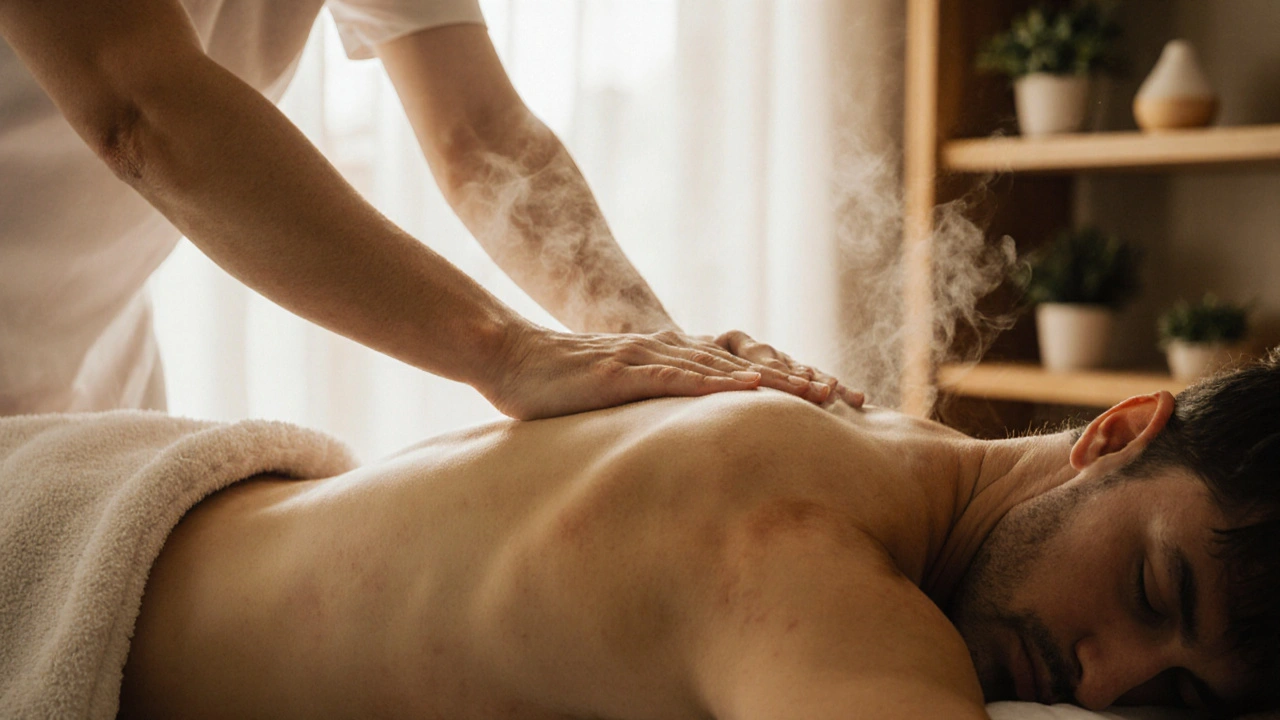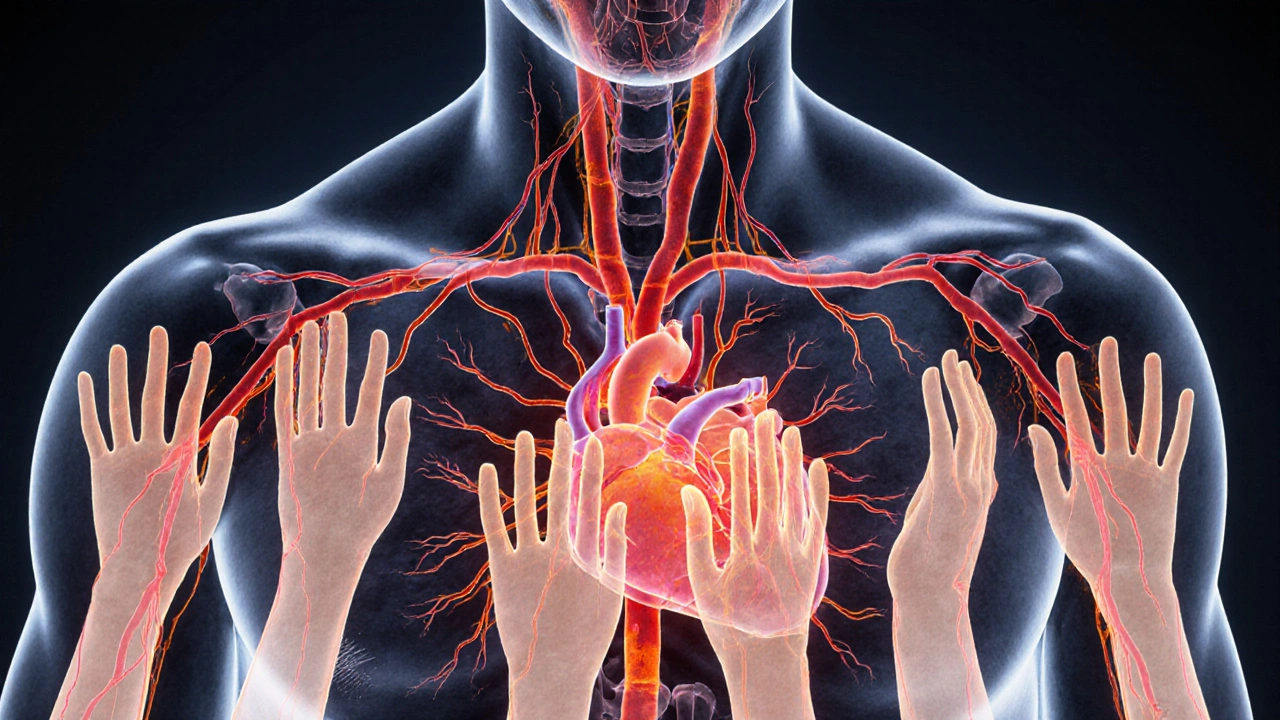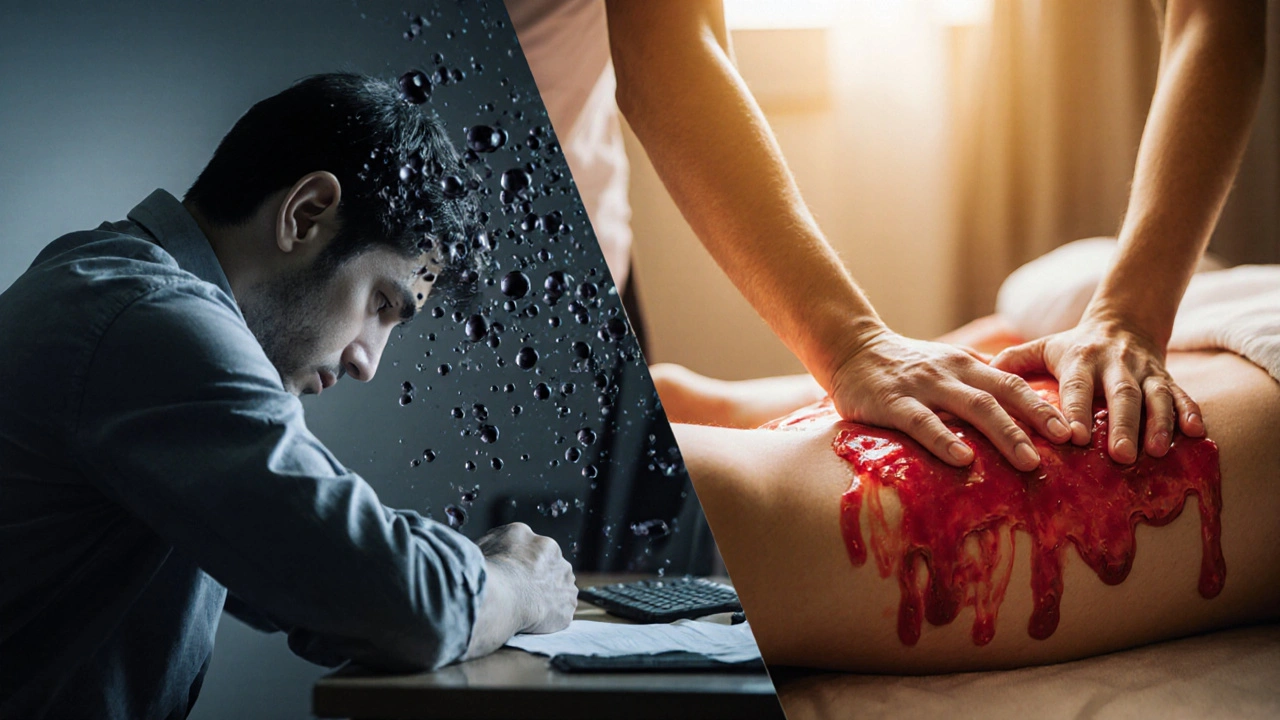Unwind in the heart of London with the best massage experiences. Explore different styles, benefits, tips for choosing the perfect therapist, and a detailed guide to maximize your relaxation journey.

- Created by: Archer Caldwell
- Completed on: 24 Nov 2025
- Categories: Swedish Massage
You’ve probably heard that Swedish massage feels amazing-but did you know it’s one of the most effective ways to get your blood moving? If you’ve ever felt that warm, tingling release after a session, that’s not just relaxation. That’s your circulatory system waking up. And it’s not magic. It’s science.
What Swedish Massage Actually Does to Your Blood
Swedish massage isn’t just about gentle strokes. It’s a targeted technique designed to stimulate blood flow using five core movements: effleurage (long gliding strokes), petrissage (kneading), friction (deep circular pressure), tapotement (rhythmic tapping), and vibration. These aren’t random motions-they’re engineered to physically push blood through vessels, especially in areas that get stiff or sluggish from sitting, standing, or stress.
When a therapist applies pressure with their hands, they’re essentially acting like a pump. Blood pooled in your legs after a long day? It gets pushed back toward your heart. Oxygen-deprived muscles? They get flushed with fresh, nutrient-rich blood. A 2021 study in the Journal of Bodywork and Movement Therapies found that just 45 minutes of Swedish massage increased blood flow in the forearm by up to 47% during and immediately after treatment. That’s not a placebo. That’s physics and physiology working together.
Why Better Circulation Matters More Than You Think
Think of your bloodstream like a city’s road network. If traffic jams up in one area, everything else slows down. Poor circulation means less oxygen to your brain, slower muscle recovery, colder hands and feet, and even more fatigue. Over time, it can contribute to swelling, numbness, or even higher blood pressure.
Swedish massage helps clear those jams. The rhythmic pressure opens up capillaries and encourages veins to contract more efficiently. This isn’t just about feeling warm-it’s about improving how your body heals, performs, and recovers. Athletes use it to reduce lactic acid buildup. Office workers use it to fight the numbness from sitting all day. Seniors use it to prevent fluid retention in the legs.
And here’s something most people miss: better circulation means your immune system works better. White blood cells travel through your blood to fight infection. If those cells can’t move freely, your body’s defenses weaken. Regular Swedish massage has been linked to increased lymphatic drainage and higher counts of circulating immune cells in several clinical trials.
How It Compares to Other Massage Types
Not all massages are built the same. Deep tissue massage digs into muscle knots-great for chronic pain, but not always ideal for circulation. Thai massage uses stretches and pressure points-powerful, but more intense. Sports massage targets specific muscles for performance.
Swedish massage? It’s the gold standard for gentle, full-body circulation boost. It doesn’t break down tissue-it encourages flow. Think of it like a slow, steady river versus a flash flood. One cleanses; the other overwhelms.
| Feature | Swedish Massage | Deep Tissue Massage |
|---|---|---|
| Primary Goal | Relaxation and circulation | Release deep muscle tension |
| Pressure Level | Light to moderate | Heavy, focused |
| Best For Circulation | Yes-gentle, full-body stimulation | Partially-localized, can cause temporary inflammation |
| Post-Session Sensation | Warm, light, energized | Sore, tight, sometimes bruised |
| Frequency Recommended | Weekly or biweekly | Every 2-4 weeks (for injury recovery) |
What Happens During a Typical Session
You’ll usually lie on a padded table, covered with a towel. The room is warm, dim, and quiet-maybe with soft music or the sound of running water. The therapist starts with your back, using long, smooth strokes from your lower back up to your shoulders. That’s effleurage-designed to warm up the tissue and get blood flowing.
Then comes kneading-petrissage-on your hamstrings, calves, and upper back. You’ll feel the muscles soften. You might even sigh without meaning to. After that, the therapist works on your arms, hands, and feet. These areas are rich in capillaries, and stimulating them helps circulate blood back to your core.
The whole session lasts between 60 and 90 minutes. No music? No problem. Some people prefer silence. The key is consistency, not the playlist. And yes, you can ask for lighter or firmer pressure. It’s your body.

Who Benefits Most From This?
Swedish massage isn’t just for people who want to unwind. It’s a practical tool for:
- People with sedentary jobs-if you sit at a desk all day, your legs and lower back get sluggish. Massage helps prevent pooling.
- Older adults-as we age, circulation slows. Regular sessions reduce swelling and improve mobility.
- Recovering injury patients-after surgery or a sprain, gentle massage can speed healing by bringing nutrients to damaged tissue.
- People with Raynaud’s syndrome-a condition where fingers and toes turn cold and numb. Studies show Swedish massage improves peripheral blood flow significantly.
- Anyone feeling tired or stressed-stress constricts blood vessels. Massage reverses that.
One client in London, a 68-year-old retired teacher, started weekly sessions after developing chronic cold feet. Within six weeks, she said she no longer needed wool socks indoors. That’s circulation.
How to Find a Good Swedish Massage in London
London has hundreds of spas, wellness centers, and mobile therapists. But not all offer true Swedish massage. Here’s how to spot the real deal:
- Look for therapists certified by the Complementary and Natural Healthcare Council (CNHC) or the British Association of Massage and Bodywork (BAM).
- Ask if they use the five classic Swedish strokes. If they say "I just do relaxation," they might not know the technique.
- Check reviews mentioning "flow," "warmth," or "tingling"-those are signs of improved circulation.
- Avoid places that bundle it with aromatherapy or hot stones unless you want extra. The base technique matters most.
- Neighborhoods like Notting Hill, Hampstead, and Shoreditch have reputable studios with trained therapists. Some even offer home visits.
What It Costs and How to Book
In London, a 60-minute Swedish massage typically costs between £60 and £90. Mobile therapists may charge £10-£20 extra for travel. Premium spas in Mayfair or Knightsbridge can go up to £120, but you’re paying for ambiance, not better results.
Bookings are easy. Most places let you book online through their website or apps like Treatwell or Spabooker. Look for packages-some offer 3-session bundles at a discount. First-time clients often get 10-15% off.
Pro tip: Schedule your session in the afternoon, not right before bed. The increased circulation can make you feel slightly alert. You’ll sleep better later.

Safety and What to Avoid
Swedish massage is safe for most people. But avoid it if you have:
- Active blood clots (deep vein thrombosis)
- Recent surgery or open wounds
- Severe osteoporosis
- Uncontrolled high blood pressure
If you’re on blood thinners, tell your therapist. They’ll adjust pressure. Never push through pain. A good session should feel deeply relaxing, not bruising.
Hydrate after your session. Your body’s flushing out metabolic waste. Drinking water helps your kidneys process it faster and reduces any post-massage fatigue.
Frequently Asked Questions
Can Swedish massage lower blood pressure?
Yes-temporarily. Multiple studies, including one from the University of Miami, show that regular Swedish massage reduces both systolic and diastolic blood pressure by an average of 10-15 points. This isn’t a replacement for medication, but for people with mild hypertension, it’s a proven complementary tool.
How often should I get a Swedish massage for circulation?
For general circulation support, once a week is ideal. If you’re dealing with chronic stiffness or cold extremities, twice a week for 4-6 weeks can make a noticeable difference. After that, maintenance every two weeks keeps things flowing.
Does Swedish massage help with varicose veins?
It can help manage symptoms, but won’t cure them. Gentle strokes toward the heart improve blood return and reduce swelling. But direct pressure over bulging veins should be avoided. Always tell your therapist if you have varicose veins-they’ll adjust their technique.
Is Swedish massage the same as relaxation massage?
Almost-but not always. Swedish massage is a specific technique with defined strokes. Relaxation massage is a goal, not a method. Some therapists call any light massage "relaxation," even if they’re not using the five Swedish strokes. Ask for "Swedish" specifically if circulation is your goal.
Will I feel sore after?
Not usually. Unlike deep tissue, Swedish massage shouldn’t leave you tender. You might feel slightly tired or deeply relaxed, but not sore. If you do feel achy, the pressure was too firm. Speak up next time.
Ready to Feel the Difference?
If you’ve been feeling sluggish, cold, or just plain drained, your body might be begging for better circulation. Swedish massage isn’t a luxury-it’s a simple, natural way to help your blood do its job. No pills. No machines. Just hands, pressure, and time.
Book your first session this week. Your veins will thank you.
Looking for the best relaxing massage in London? Discover how to unwind and recharge with top-rated massage experiences, tips, and inside info about what really works.
This guide gives you the lowdown on outcall massage—what it is, why it’s awesome, and how to book it safely. You’ll learn about the different types of massages you can get right in your living room and how much you might pay. We’ll walk through how a session actually feels, how to find the best services, and how to keep things safe and comfortable. There’s even a handy comparison table and answers to all your burning questions. Ready to bring the spa to your sofa? This article covers everything you need.




Jeremy Hunt
November 24, 2025 AT 17:49I got my first Swedish massage last month after sitting at a desk for 12 hours a day, and holy hell-it was like my legs remembered how to feel warm again. No more numb toes at 3 p.m. I used to blame it on bad shoes. Turns out, my blood was just stuck in traffic. Now I go every other week. Best $70 I spend.
Also, the therapist in Toronto said something I’ll never forget: "Your veins aren’t pipes. They’re rivers. And rivers need flow, not just pressure." Mind blown.
Amy Black
November 25, 2025 AT 21:36That 2021 study in the Journal of Bodywork and Movement Therapies is legit. I’ve reviewed similar papers on vascular response to manual therapy. The 47% increase in forearm blood flow aligns with Doppler ultrasound data from controlled trials. What’s often missed is that the effect is transient-lasting 2-4 hours post-session-but repeated exposure builds cumulative vascular efficiency. Not magic. Not placebo. Just biomechanics.
Elle Daphne
November 26, 2025 AT 23:16OMG YES THIS IS LIFE CHANGING I WAS SO COLD ALL THE TIME LIKE SERIOUSLY MY FINGERS WERE BLUE IN JULY AND NOW I CAN WEAR SHORT SLEEVES WITHOUT FEELING LIKE I’M IN A FRIDGE???
My therapist in Austin told me to think of it like a gentle hug for my capillaries and I cried because no one had ever described it that way before. Also my mom who has diabetes started doing this and her foot ulcers are healing faster. Science is cool but sometimes you just need someone’s hands to remind your body it’s still alive.
Book it. Do it. Tell your boss you need a circulation upgrade. You deserve it.
La'Sherrell Robins
November 28, 2025 AT 00:21ok but like… why are we still talking about this like it’s some deep secret??
my bff got a massage after her c-section and her legs stopped looking like overcooked sausages. my uncle with gout swears by it. even my cat stretches out when i rub her belly like she’s trying to summon a Swedish massage fairy.
if you’re not doing this you’re basically telling your blood to take a nap on the job. and i’m not here for it. get your flow on, people. no excuses. your veins are begging.
also i got a free session from my gym and now i’m addicted. like, i text my therapist at 2am like ‘hey u up?’ and she just replies ‘yes’ and i cry happy tears. this is therapy. and i’m not even joking.
Nick LoBrutto
November 29, 2025 AT 14:25Minor correction: The study cited measured forearm blood flow, but it’s worth noting that the effect varies by body region-lower limbs show more modest increases due to gravity and venous resistance. Also, the 47% figure is peak increase during treatment, not sustained. That said, the overall mechanism checks out. Effleurage’s unidirectional stroke pattern mimics venous return, and petrissage helps compress muscle bellies to squeeze out pooled blood.
Side note: The comparison table is accurate. Deep tissue can actually impede circulation temporarily by causing microtrauma and inflammation. Swedish is the slow, steady win. Like composting vs. a bonfire.
Tatiana Pansadoro
December 1, 2025 AT 13:01Don’t let anyone tell you it’s just a luxury. It’s a right.